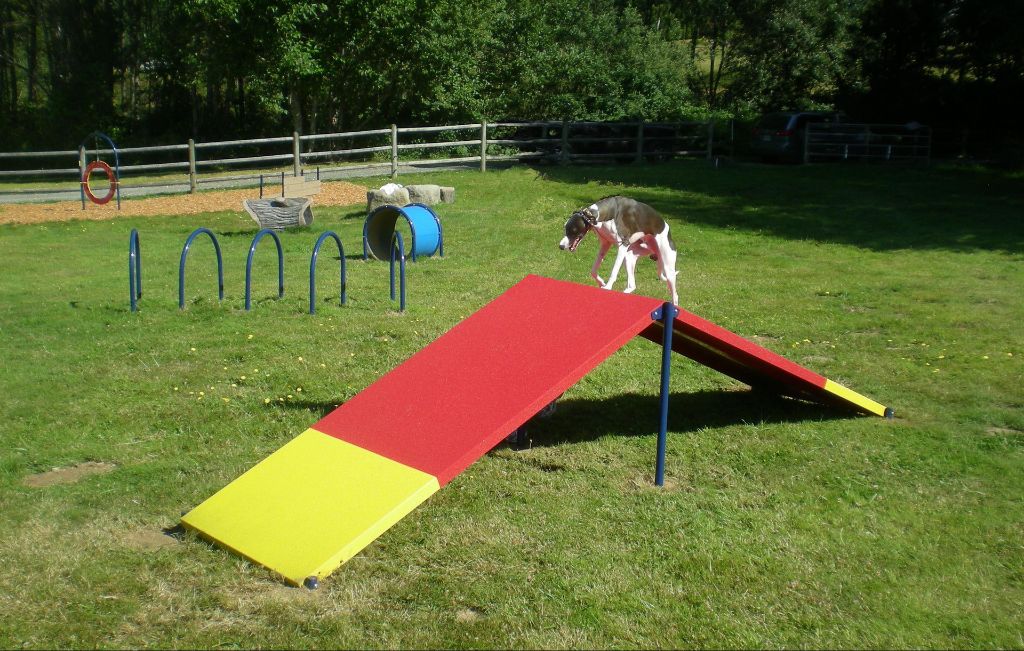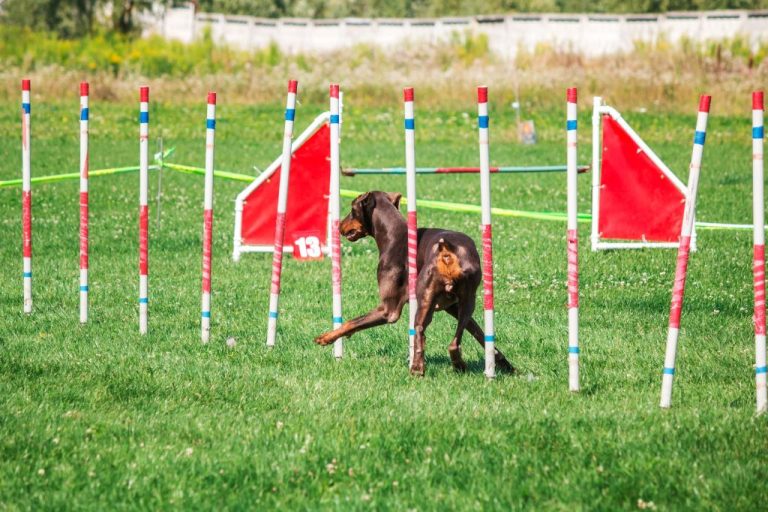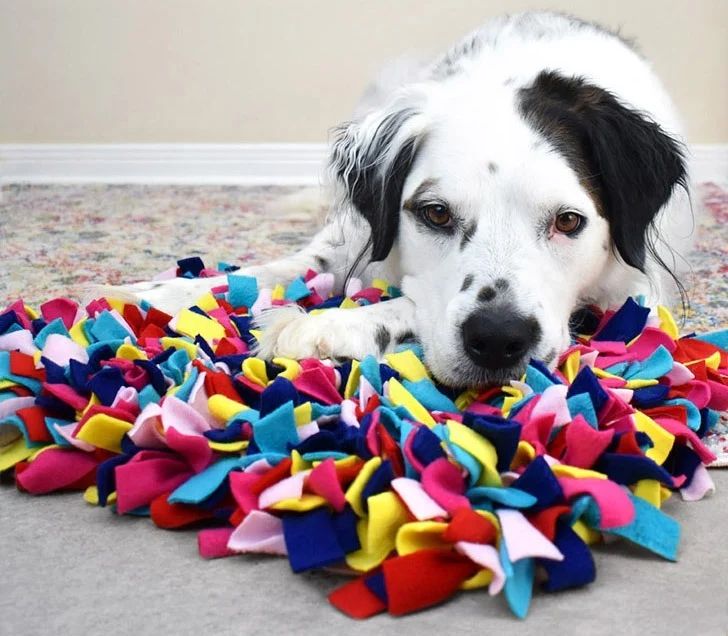Obstacle Course Challenge For Dogs
An obstacle course for dogs typically consists of various equipment like tunnels, jumps, weave poles, seesaws, and more arranged into a continuous path. It allows dogs to exercise both physically and mentally as they navigate the course. Obstacle courses are a core component of canine sports like agility and are also used by pet owners for fun and training.
Obstacle courses provide an engaging form of exercise for dogs. Negotiating the various obstacles builds physical skills like balance, coordination, speed, and endurance. It satisfies dogs’ natural instincts to jump, climb, weave, and explore. Mentally, it challenges dogs to problem solve as they figure out how to tackle each new obstacle.
Regular practice on obstacle courses can strengthen the bond between dogs and their handlers. It’s an interactive way to train dogs and provide mental stimulation. Obstacle course runs can be turned into fun games or competitions for dogs. Overall, it’s a great activity that combines physical activity, mental exercise, training, and quality time between pets and owners.
Safety Precautions
When training dogs on an obstacle course, it’s crucial to take safety precautions to avoid injury. As the ASPCA notes, “Improper use of agility equipment may result in serious injury to a dog or handler” (ASPCA). Following proper techniques and guidelines is key.
Before allowing a dog to use agility equipment, they must be trained on how to properly and safely maneuver each obstacle. Always start with low heights and easy challenges to build confidence. Reinforce desired behaviors with praise and treats. Dogs should demonstrate mastery at lower levels before progressing to more advanced equipment and heights.
It’s also vital to adjust equipment size and height to suit the specific dog. Larger and higher steps for bigger dogs, and smaller low-to-the-ground equipment for smaller dogs. Ensuring proper fit minimizes risk of injury. Allowing a small dog to attempt tall A-frame steps designed for much larger dogs could lead to pulled muscles, sprains, or falls.
Additionally, limit training times and provide ample warm up and cool down periods. As the AKC notes, “Dogs need conditioning to avoid injury” (AKC). Don’t overdo training periods, especially for young puppies. Providing recovery time allows dogs’ bodies to adapt to new physical demands.
Equipment Needed

A standard dog agility course requires a variety of equipment that you can purchase such as:
- Tunnels – curved and straight tunnels for dogs to run through (Dog Agility Equipment – Clean Run)
- Jumps – hurdles for dogs to leap over, including single, double, triple, broad jumps (Dog Agility Equipment | Tunnels, Poles, Jumps)
- A-frame – a pair of ramps in an A shape for dogs to climb up and down
- Dog walk – a long plank raised on legs for dogs to walk across
- Teeter totter – a seesaw-like plank that tips as dogs cross it
- Weave poles – a row of vertical poles that dogs weave in and out of
- Pause table – a platform where dogs must pause briefly
Other obstacles like tires, swinging planks, and crawling tubes can also be added. It’s important to get regulation size and style equipment or train with the dimensions used in competitions. Safety is also key – look for equipment with good traction, no sharp edges, and secure construction.
Setting Up the Course
When setting up an obstacle course for your dog, it’s important to lay out the various obstacles thoughtfully. Here are some tips for connecting the obstacles to create a flowing course:
Start by sketching out your available space and deciding where you want to place each obstacle. Leave ample room between obstacles for your dog to complete one before moving to the next. A good rule of thumb is to leave at least 6 feet between obstacles.
Arrange the obstacles so they flow smoothly in one direction, creating a natural path for your dog to follow. For example, place the jump hurdles leading up to the A-frame ramp, followed by the weave poles. Avoid any tight turns or abrupt changes in direction.
Use visual markers like cones or flags to delineate a clear path between obstacles. This will help guide your dog from one obstacle to the next. Mark the start and finish lines as well.
Securely connect movable obstacles like jumps and weave poles so they don’t shift during use. Use stakes, weights or an anchor system to keep them stable.
Check over your course for potential tripping hazards and fill any holes or gaps. Make sure the ground is level. Remove sticks, rocks and other debris.
Start with a simple course of 5-6 obstacles and few direction changes. You can make it more complex over time as your dog’s skills develop. But keep safety top of mind when designing courses.
Refer to This Old House’s guide for tips on connecting specific obstacles like hurdles, ramps, and tunnels (https://www.thisoldhouse.com/pets/21016642/how-to-build-a-dog-agility-course). With smart layout and secure setup, you’ll have a safe DIY agility course for your dog.
Training the Dog
When training your dog for an obstacle course, it’s important to introduce obstacles slowly and at your dog’s pace. According to the AKC, start with basic obedience training and then introduce one piece of equipment at a time once your dog is comfortable with the commands [1]. Work at short sessions of just a few minutes at first to keep your dog’s interest. Make sure to use plenty of encouragement, treats, and praise when your dog completes an obstacle or sequence successfully.
The Spruce Pets recommends starting with basic equipment like tunnels or low jumps. Build your dog’s confidence on easy obstacles before moving to more challenging equipment like the A-frame or weave poles [2]. Break down complex obstacles like the weave poles into small steps so your dog can master one part at a time. Be patient and keep training sessions relaxed and fun. End on a positive note after a successful sequence so your dog is left wanting more.
With a gradual introduction and lots of positive reinforcement, you can build your dog’s agility skills and confidence at their own pace. Keep training sessions short, active and rewarding, and your dog will be completing their own obstacle courses in no time!
[1] https://www.akc.org/expert-advice/training/10-tips-to-practice-agility-at-home-with-your-dog/
[2] https://www.thesprucepets.com/agility-training-for-dogs-1118557
Fun Obstacle Ideas
You can get creative and use a variety of everyday household items for fun DIY agility obstacles. Some fun ideas include:
Pool noodles – Use pool noodles to create jumps and uprights. Cut the noodles to size and secure them together with duct tape. Pool noodles allow the jumps to bend if hit, reducing risk of injury [1].
Broomsticks – Lay a broomstick on the ground between two cones or blocks to create a simple jump. Adjust the height by using taller cones or raising the broomstick [2].
Tires – An old tire can become a “tire jump” when secured upright or lying flat on the ground. Decorate the tire with streamers or ribbons to make it visually interesting.
Tunnels – Use a rigid plastic kids tunnel or make tunnels from large cardboard boxes for your dog to run through.
Weave poles – Set up a line of mop or broom handles in the ground at angles for dogs to weave through. Space the poles close enough so dogs must wind through them.
Ramps – Furniture ramps, skateboard ramps, and slides made of wood or plastic can become agility ramps. Start low and add gentle inclines.
Balance equipment – Place a sturdy wood board between concrete blocks or bricks for dogs to walk across. Or have them walk across a ladder lying flat on the ground.
[1] https://www.oneminddogs.com/blog/diy-agility-obstacles/
[2] https://www.superpup.academy/blog/cheap-diy-dog-agility-equipment-hacks
Hosting Competitions
Organizing fun obstacle course games and competitions with other dogs is a great way to socialize your pup and keep them active. Here are some tips for hosting your own backyard dog agility competition:
Set up several stations with different obstacles like tunnels, jumps, weave poles, and hoops. Allow dogs to run through the course one at a time and time each run. Consider giving out prizes like treats or ribbons to the fastest dogs.
To make it more challenging, designate different obstacle courses for small, medium, and large dogs. Small dogs can have lower jumps while larger dogs navigate higher hurdles.
Have dog owners take turns operating the course and rewarding dogs after they complete a run. Make sure to clean and sanitize equipment between each dog’s turn.
In addition to races, incorporate tricks and commands into the competition. See which dog can quickly sit, lie down, spin in a circle on command, etc. This makes it fun for dogs of all ages and athletic abilities.
Host a backyard barbecue alongside the obstacle course competition to make it a social event. Offer dog-safe treats as snacks for pups. And be sure to take lots of pictures and videos to share with the other owners afterwards!
See these sources for more ideas on creating your own DIY dog agility course for backyard competitions:
Agility & Dog backyard ideas,
How to Create a DIY Agility Course in Your Backyard
Overcoming Common Issues
Dogs participating in obstacle courses can sometimes run into problems learning the obstacles or performing them consistently (Baddogagility, 2022). Some common issues include a fear of height, refusal of jumps, lack of motivation, difficulty with signaling from the handler, and overall slow run times (Carlson-agility, 2023).
To help a dog afraid of obstacles like the A-frame or teeter, start by placing the object on the ground and allowing the dog to approach and become comfortable with it. Give treats and praise for any interaction at first. Gradually lift up one side just a few inches to start exposing the dog to the movement and height. Take training slow and keep sessions positive and fun. For dogs afraid of the tunnel, begin training similarly with a very short tunnel section on the ground, allowing the dog to move through it freely while earning rewards (Baddogagility, 2022).
For jump refusals, first ensure the jump bar is set at the proper low height for the dog’s size. Practice jumping without the bar at first, luring the dog over with treats if needed. Slowly add the bar back while keeping it very low. Increase the height gradually as the dog gains confidence. Make sure to praise and reward each successful jump (Carlson-agility, 2023).
Other common training techniques to overcome issues include using targets and mats to guide the dog properly through courses, slowing down runs and breaking courses into individual sequence pieces, and using toys and play to increase drive and motivation (Baddogagility, 2022). Consistency, patience, and keeping training fun are key to working through any obstacles.
Benefits for Dogs
Agility training provides many benefits for dogs, both physical and mental. It improves a dog’s coordination as they learn to navigate obstacles and challenges. The training requires dogs to problem solve as they figure out how to complete each obstacle. It also provides great bonding time between a dog and their owner as they work together during training sessions.
As dogs maneuver through tunnels, jump over hurdles, and walk across teeter boards and other equipment, they build strength, balance, and body awareness (VCA Hospitals). Their coordination improves as they learn how to control their body and paws on different surfaces and obstacles.
Agility training also provides mental stimulation for dogs as they have to listen to cues from their handler and decide how to tackle each obstacle. As they navigate courses, dogs use problem-solving skills to figure out the best approach (Hill’s Pet Nutrition). This gives their mind a workout along with their body.
Additionally, agility strengthens the bond between dogs and their owners. As they work together through the course, communication and teamwork improves. Dogs get one-on-one attention and praise from their handler, building trust and connection (The Wildest).
Conclusion
Training dogs on obstacle courses offers many great benefits for pets and their owners. By setting up a backyard obstacle course, you can provide your dog with much-needed physical and mental stimulation. The course helps improve your dog’s agility, obedience, focus, and bonding with you.
Start by ensuring you have the proper equipment and setting up a safe space. Then begin working on basic training before introducing obstacles like tunnels, jumps, teeter totters, and weave poles. Always keep training sessions positive and reward your dog for progress. With regular practice, your dog will gain confidence navigating the challenges.
Obstacle courses are not only great exercise but also provide quality bonding time with your pet. Consider hosting competitions with other dog owners and allowing dogs to socialize. Most importantly, have fun with your furry companion while supporting their health and happiness through this enriched activity.





